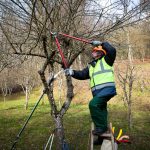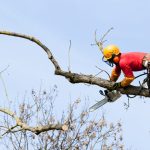Best Mulch for Trees
Trees in their natural habitat exist in forests where the ground is covered with a continually renewing layer of decaying material. For a tree to thrive in your yard, the best method of nourishment is to provide organic mulch that degrades quickly for easy absorption. But what is the best mulch for trees in your yard?
Organic mulch may take the form of ground-up yard debris as well as yard service debris or chipped branches and leaves. Using these materials also tidies up your yard while recycling debris into usable material. In many cases, you can create your own mulch for use around trees, planting beds, and even your garden.
Best Mulch for Trees
In Portland’s climate, which features wet winters and dry summers, selecting the right mulch is crucial. Here are some suitable options that can improve soil structure and help feed plant roots:
- Organic Mulch
- Compost
- Straw or Hay
- Leaves
This can all be considered organic, but you probably don’t have a bunch of hay or wood chips at your disposal. And creating compost from appropriate food scraps and grass clippings may take a while to accumulate and curate. Depending on when you plant your trees, you will need to plan ahead or look for store-bought options.
Leaves, of course, will be in abundance come the Fall.
 Organic Mulch (Wood Chips or Bark)
Organic Mulch (Wood Chips or Bark)
Organic mulches like wood chips, bark, or shredded bark and tree limbs are commonly used around the base of the trees in Portland. They help retain moisture in the soil, regulate soil temperature, and are good at preventing weeds. Wood chips are readily available from local arborists or tree service companies.
Compost
You may already have a compost bin that you use to recycle the right kinds of table scraps–you can use that compost as a mulch around trees! It enriches the soil with nutrients and improves its structure. However, it should be applied in a thin layer to avoid suffocating the tree roots: no more than two to four inches deep.
Proper food compost should contain fruit and vegetable scraps, coffee grounds and filters, crushed eggshells, stale bread, pasta, rice, nut shells, and cereal are all viable options for your compost bin. Avoid meat, fish, and dairy products as they can attract pests and stay away from oily or greasy foods because they can slow down decomposition.
Straw or Hay
Straw or hay mulch can help conserve moisture and reduce soil temperature fluctuations. This layer of mulch is also great for reducing weeds, too. But be cautious about weed seeds in the hay, and use straw instead if possible. However, straw is low in nutrients so it won’t feed the soil.
Leaves
Every November, there is an abundance of tree leaves on your lawn, flower beds, driveway, and so on. Using leaves serves two purposes: One, it gets that thick layer of leaves off your lawn and other landscaping where it can kill vegetation underneath. And two, shredded leaves from deciduous trees can make excellent mulch.
While they naturally break down over time and add organic matter to the soil, make sure to shred them. This will give you better, more even coverage and prevent them from matting together.
How to Apply the Best Mulch for Trees in Portland
Once you have decided on your type of mulch, your next step is to decide how you will lay it down to best benefit your tree. Avoid using a weed mat, as these and other fabric/plastic laid beneath organic mulch remove many benefits by placing a barrier between soil and mulch.
Your goal when applying mulch is to enrich the soil with nutrients from broken-down organic materials. Fabric prevents beneficial organisms like earthworms from proliferating in the soil, and materials such as polyethylene plastic block both air and water and can severely deplete the tree if the root zone is covered.
The best way to accomplish this is to simply lay down mulch over the turf surrounding your previously-mulched area. As the turf beneath the new mulch degrades, it too will turn to rich material that will benefit your tree further.
Spread the mulch out evenly to just beyond the drip line of the tree. This is where rainwater falls naturally from the tree and will keep the feeder roots healthier. Do not bring the mulch all the way up to the tree trunk or pile mulch up the tree trunk. Keep the mulch two to four inches away from the trunk to prevent moisture or pest damage.
Even with the proper mulch, area awareness is key. The larger the mulched area, the better. A five-foot mulch ring around an eight-inch diameter tree, for instance, provides a good baseline. However, it is in the best interest of the tree to gradually increase the mulched area.
For those concerned about pests that may live in mulch and spread throughout the yard, it is worth noting that most of these organisms are insects that prey on other insects and serve to recycle the very matter that is nourishing your tree.
Other Considerations
However, if you are concerned, take measures to ensure that the mulch you lay around your tree does not touch the foundations of your house and that bare, dry ground stretches 12 to 18 inches from your foundation to the mulched area.
In addition, keep landscape shrubs back at least three or four feet from the foundation, where the roof overhang should keep the underlying soil dry. Do not leave organic refuse or soiled garbage that would attract small critters away from the mulch and into your home or garage.
Many homeowners take issue with mulch, worried that it decreases soil nitrogen. While there is no conclusive evidence that mulch permanently depletes the soil in this way, nitrogen levels can be depleted temporarily while the organic material decomposes.
While this process can last from weeks to months depending on soil temperatures, the nitrogen in use during the decomposition process is returned to the soil once the cycle is complete, where it will again benefit your tree.
Mulching is one of the most essential ways to care for your tree, and by using organic mulch, you turn yard debris into a precious resource for the continued health and beautification of your yard. After all, trees are one of those things that make Portland so attractive and keep Oregon green.
Beyond the Best Mulch for Trees: Inexpensive Tree Care Services
Even with proper mulching, trees still need regular maintenance. This could include pruning, trimming, repair, and other steps to keep it strong and healthy. Inexpensive Tree Care uses arborists to inspect your tree and make recommendations for how best to take care of it.
And if it’s time to take the tree down, we are here to do it safely to prevent any issues that may happen if it decides to drop a large branch, or just fall over on its own without warning. Wondering about the size, position, or health of your tree? Give us a call and we’ll let you know.




